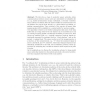GECCO
2007
Springer
14 years 6 months ago
2007
Springer
Biologically inspired designs can improve the design of artificial agents. In this paper we explain and explore the role of directional light sensors from an Evolutionary Robotic...
GECCO
2007
Springer
14 years 6 months ago
2007
Springer
A significant problem for evolving artificial neural networks is that the physical arrangement of sensors and effectors is invisible to the evolutionary algorithm. For example,...
EUSAI
2007
Springer
14 years 6 months ago
2007
Springer
A low-cost kit of stick-on wireless sensors that transmit data indicating whenever various objects are being touched or used might aid ubiquitous computing research efforts on rapi...
DCOSS
2007
Springer
14 years 6 months ago
2007
Springer
We introduce a class of anchoritic sensor networks, where communications between sensor nodes are undesirable or infeasible due to, e.g., harsh environments, energy constraints, or...
ALGOSENSORS
2007
Springer
14 years 6 months ago
2007
Springer
Scalable energy-efficient training protocols are proposed for massively-deployed sensor networks, where sensors are initially anonymous and unaware of their location. The protocol...
LCN
2007
IEEE
14 years 6 months ago
2007
IEEE
—This paper examines the process of customizing Particle sensors for use in a home energy monitoring project. Our developments affected sensor hardware, sensor software and data ...
IROS
2007
IEEE
14 years 6 months ago
2007
IEEE
— This paper presents a new technique for the update of a probabilistic spatial occupancy grid map using a forward sensor model. Unlike currently popular inverse sensor models, f...
INFOCOM
2007
IEEE
14 years 6 months ago
2007
IEEE
— We propose new algorithms to achieve k-coverage in dense sensor networks. In such networks, covering sensor locations approximates covering the whole area. However, it has been...
INFOCOM
2007
IEEE
14 years 6 months ago
2007
IEEE
— Though destructive to network functions, insider attackers are not detectable with only the classic cryptographybased techniques. Many mission-critic sensor network application...
INFOCOM
2007
IEEE
14 years 6 months ago
2007
IEEE
Abstract—It may not be feasible for sensor networks monitoring nature and inaccessible geographical regions to include powered sinks with Internet connections. We consider the sc...






